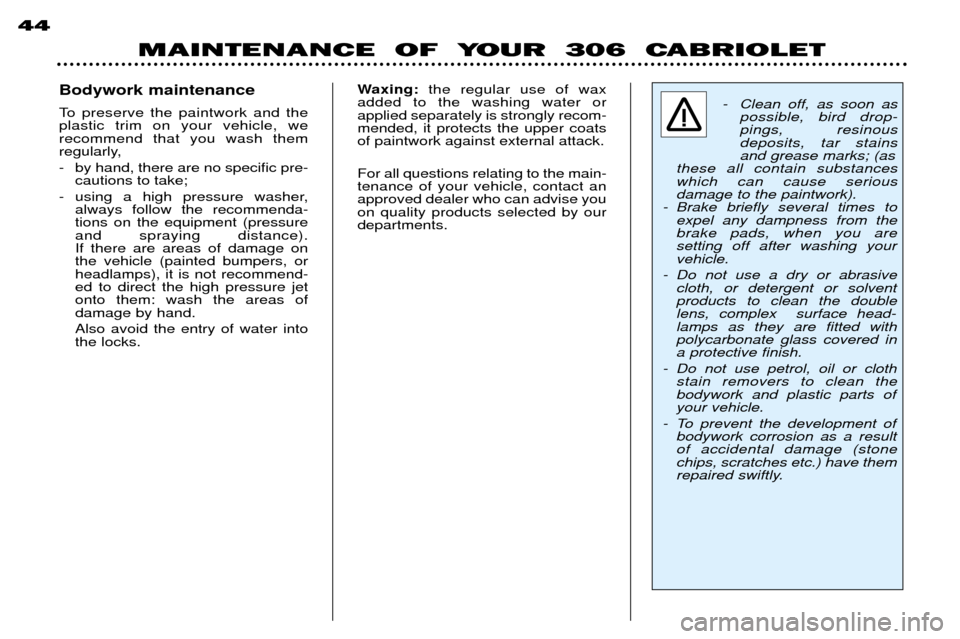Page 110 of 133

A
B
A
B
MAINTENANCE OF YOUR 306 CABRIOLET
26
CHECKING THE LEVELS Engine Checking the oil level Check the level regularly and top up between changes
(maximum
consumption is 0.5 litres per 600 miles (1,000 km). The oil level should be checked with the vehicle level, engine cold. There are two marks on the dipstick:
A= maximum.
B = minimum. Oil change:
according to the manu-
facturerÕs servicing schedule.
Ð Dipstick. Never fill past the maximum mark A.
Ð Oil level gauge on the instrument panel.
Viscosity selectionIn all cases, the oil selected must meet the manufacturer's require-ments. Oil filter Change the filter regularly in accor- dance with the maintenance schedule. Used oil Prevent used oil from coming into pro- longed contact with the skin. Do not dispose of used oil into drains or into the ground.
To maintain the reliability of engines and emission control systems, the useof additives in the engine oil is pro-hibited. Brake fluid reservoir
Ð The level should always be above
the DANGER mark on the reservoir.
Ð If the level drops substantially, contact a PEUGEOT dealer imme-
diately.
Fluid change
Ð must be carried out according to the manufacturerÕs schedule.
Ð use fluids approved by the manu- facturer, which fulfil DOT4 stan- dards.
Coolant reservoir Use the fluid approved by the manu-
facturer. When the engine is warm, the tem- perature of the coolant is controlledby the engine fan: because this fancan operate with the ignition keyremoved, and because the coolingsystem is pressurised, wait for at leastone hour after the engine has stoppedbefore carrying out any work.
If necessary, in a breakdown, slacken the cap to the first notch to release thepressure to prevent any risk of scald-ing. When the pressure has droppedremove the cap and top up the level.
Page 111 of 133

MAINTENANCE OF YOUR 306 CABRIOLET27
Power steering reservoir
Open the reservoir, with the engine
cold. The level should always beabove the MINI mark, close to theMAXI mark.
Windscreen and headlamp wash reservoir* For best quality cleaning and for your
safety, we recommend that you useproducts approved by PEUGEOT(capacity 4,4 litres or 6 litres withheadlight wash). Battery
At the start of winter, have your battery
checked by a PEUGEOT dealer. Air filter Regular replacement of the filter element is essential. If you drive invery dusty conditions, change it twiceas often. Brake pads Brake pad wear depends on the style of driving, in particular for vehicleswhich are used in town or for shortjourneys or which are driven in a
sporty manner. It may be necessaryto check the thickness of the padseven between services. Manual gearbox This does not need an oil change. Check the level according to the man-
ufacturerÕs service schedule. Autoadaptive automatic gearbox This does not need an oil change: have the level checked by a
PEUGEOT dealer according to the
manufacturerÕs service schedule.
Only use products
approved by Automobiles
PEUGEOT.
To ensure best perfor-
mance from components as impor- tant as the power steering and thebraking system, PEUGEOT selectsand offers quite specific products. Fuel supply cut-off* In a serious collision, a system pre- vents fuel from reaching the engine.
To re-establish the fuel supply, press the switch on the angle of the front
left-hand suspension assembly, underthe bonnet.
* According to specification.
Page 126 of 133
TOWING
Without lifting (four wheels on the ground)
You must always use a towbar. From the front or the rear Attach the towbar to the towing eye. By lifting (two wheels only on the ground) It is preferable to lift the vehicle by the wheels.
Never use the radiator crossmember.
MAINTENANCE OF YOUR 306 CABRIOLET
42
Special features of the automatic gearbox When towing with four wheels on the ground, the following rules must beobeyed:
Ð lever in position N,
Ð tow the vehicle at less than 30 m.p.h. (50 km/h) over a maximum distance of 30 miles (50 km),
Ð do not add oil to the gearbox.
Page 128 of 133

MAINTENANCE OF YOUR 306 CABRIOLET
44
Bodywork maintenance
To preserve the paintwork and the plastic trim on your vehicle, we recommend that you wash them
regularly,
- by hand, there are no specific pre-cautions to take;
- using a high pressure washer, always follow the recommenda- tions on the equipment (pressureand spraying distance).If there are areas of damage onthe vehicle (painted bumpers, orheadlamps), it is not recommend-ed to direct the high pressure jetonto them: wash the areas ofdamage by hand. Also avoid the entry of water into the locks. Waxing:
the regular use of wax
added to the washing water orapplied separately is strongly recom-mended, it protects the upper coatsof paintwork against external attack. For all questions relating to the main- tenance of your vehicle, contact anapproved dealer who can advise youon quality products selected by ourdepartments. - Clean off, as soon as
possible, bird drop-pings, resinousdeposits, tar stainsand grease marks; (as
these all contain substanceswhich can cause serious damage to the paintwork).
- Brake briefly several times to expel any dampness from thebrake pads, when you are setting off after washing yourvehicle.
- Do not use a dry or abrasive cloth, or detergent or solventproducts to clean the doublelens, complex surface head-lamps as they are fitted withpolycarbonate glass covered ina protective finish.
- Do not use petrol, oil or cloth stain removers to clean thebodywork and plastic parts ofyour vehicle.
- To prevent the development of bodywork corrosion as a resultof accidental damage (stonechips, scratches etc.) have them
repaired swiftly.